| Prime Minister of the Republic of Indonesia | |
|---|---|
| Perdana Menteri Republik Indonesia | |
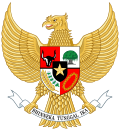 National emblem of Indonesia National emblem of Indonesia | |
 Flag of Indonesia Flag of Indonesia | |
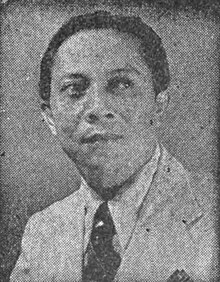 First holder First holderSutan Sjahrir 14 November 1945 – 27 June 1947 | |
| Style | His Excellency |
| Member of | |
| Residence | Pancasila Building |
| Seat | Jakarta |
| Appointer | President |
| Constituting instrument | |
| Inaugural holder | Sutan Sjahrir |
| Formation | 14 November 1945 |
| Final holder |
|
| Abolished |
|
| Deputy | Deputy Prime Minister |
The Prime Minister of the Republic of Indonesia (Indonesian: Perdana Menteri Republik Indonesia) was a political office in Indonesia which existed from 1945 until 1966. During this period, the prime minister was in charge of the cabinet of Indonesia, one of the three branches of government along with the House of Representatives and the president. Following his 1959 decree, President Sukarno assumed the role and powers of prime minister until his resignation in 1966.
Indonesian National Revolution
On 18 August 1945, a day after the Proclamation of Indonesian Independence, Sukarno was appointed president and the 1945 Constitution of Indonesia came into force, which stated that Indonesia was built around a presidential system; as such, there were no constitutional provisions for a prime minister, and the cabinet was directly responsible to the president. However following Vice-Presidential Edict No.X, on 11 November the cabinet was made responsible to the provisional legislature, the Central Indonesian National Committee (Indonesian: Komite Nasional Indonesia Pusat (KNIP)), effectively suspending the constitution. The cabinet was dismissed, and Sutan Sjahrir was asked to become the first prime minister. He agreed to do so on the condition he was allowed to select his own cabinet. The new cabinet was announced on 14 November with the understanding that although the prime minister was responsible to the Working Committee of the KNIP, he had to consult the president before making any major decisions. If the prime minister came into conflict with the KNIP or the president, another could be chosen.
Internal political disputes prompted Sjahrir to resign on 28 March, but he was asked to form the next cabinet. This fell in October, but yet again, Sjahrir agreed to continue as prime minister in the new cabinet. He finally resigned on 27 June, after being fatally weakened by concessions he had made to the Dutch following the signing of the Linggadjati Agreement. He was replaced by Amir Sjarifuddin, and Sjahrir became Indonesian representative at the United Nations. Sjariffuddin in turn resigned in turn following withdrawal of political support in the aftermath of the Renville Agreement. Sukarno then appointed vice-president Mohammad Hatta, asking him to form an emergency cabinet answerable to him rather than to the KNIP.
United States of Indonesia
On 27 December 1949, the Netherlands transferred sovereignty to a federal United States of Indonesia (RUSI), of which the Republic of Indonesia was one state. The Federal Constitution provided for a prime minister, and Hatta became the only prime minister of the RUSI. As this caused a vacuum of power in the Republican administration, Susanto Tirtoprodjo, justice minister in the previous cabinet, was appointed acting prime minister at the head of a transitional cabinet. On 22 January 1950, the new prime minister, announced his cabinet. The terms of both Hatta and Halim ended when the RUSI was dissolved and Indonesia became a unitary state on 17 August 1950 .
Liberal and Guided Democracy eras
Further information: Liberal democracy period in Indonesia and Guided Democracy in IndonesiaUnder the constitution of the unitary state, the cabinet was once again responsible to parliament, with the prime minister appointed by the president. Due to the instability of the coalition cabinets, prime ministers often faced votes of no confidence. Every major policy change had a chance to be opposed, either by the government or opposition. As such, some cabinets lasted only a few months.
On 5 July 1959, Sukarno issued a presidential decree declaring that, due to the inability of the Constitutional Assembly of Indonesia to decide on a new constitution, the 1945 Constitution would be reinstated. This removed the constitutional foundation for the office of Prime Minister. However, on 9 July of that same year, Sukarno took on the title of prime minister in addition to the presidency; later using the phrase "I am president and prime minister" as a dominant message in his speeches. After the abortive coup against the government in 1965 and the release of a document transferring all political power to Suharto, in 1967 Sukarno lost the title of prime minister together with the presidency.
List of prime ministers
- Political parties
| No. | Portrait | Name(Lifespan) | Term of office | Party | ||
|---|---|---|---|---|---|---|
| Took office | Left office | Time in office | ||||
| Indonesian National Revolution (1945–1949) | ||||||
| 1 | 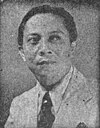
|
Sutan Sjahrir (1909–1966) |
14 November 1945 | 3 July 1947 | 1 year, 225 days | PSI |
| 2 | 
|
Amir Sjarifuddin (1907–1948) |
3 July 1947 | 29 January 1948 | 210 days | PSI |
| 3 | 
|
Mohammad Hatta (1902–1980) |
29 January 1948 | 20 December 1949 | 1 year, 325 days | Independent |
| United States of Indonesia (1949–1950) | ||||||
| 3 | 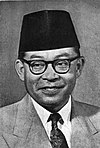
|
Mohammad Hatta (1902–1980) |
20 December 1949 | 6 September 1950 | 260 days | Independent |
| Republic of Indonesia (1949–1950) | ||||||
| — | 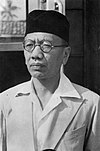
|
Susanto Tirtoprodjo (1900–1969) Acting Prime Minister |
20 December 1949 | 21 January 1950 | 32 days | PNI |
| 4 | 
|
Abdul Halim (1911–1988) |
21 January 1950 | 6 September 1950 | 228 days | Independent |
| Liberal Democracy period (1950–1959) | ||||||
| 5 | 
|
Mohammad Natsir (1908–1993) |
6 September 1950 | 27 April 1951 | 233 days | Masyumi |
| 6 | 
|
Soekiman Wirjosandjojo (1898–1974) |
27 April 1951 | 3 April 1952 | 342 days | Masyumi |
| 7 | 
|
Wilopo (1908–1981) |
3 April 1952 | 30 July 1953 | 1 year, 120 days | PNI |
| 8 | 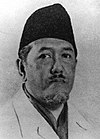
|
Ali Sastroamidjojo (1903–1976) |
30 July 1953 | 12 August 1955 | 2 years, 11 days | PNI |
| 9 | 
|
Burhanuddin Harahap (1917–1987) |
12 August 1955 | 24 March 1956 | 227 days | Masyumi |
| 10 (8) |

|
Ali Sastroamidjojo (1903–1976) |
24 March 1956 | 9 April 1957 | 1 year, 14 days | PNI |
| 11 | 
|
Djuanda Kartawidjaja (1911–1963) |
9 April 1957 | 9 July 1959 | 2 years, 91 days | Independent |
| Guided Democracy period (1959–1966) | ||||||
| 12 | 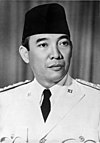
|
Sukarno (1901–1970) |
9 July 1959 | 25 July 1966 | 7 years, 16 days | Independent |
See also
- President of Indonesia
- Vice President of Indonesia
- Deputy Prime Minister of Indonesia
- Elections in Indonesia
- Politics of Indonesia
Notes
- Dutch prisoner from 19 December 1948 to 13 July 1949, and took office again on 14 July 1949.
- President, self-appointed as Prime Minister.
References
- Abdullah 2009, pp. 129–130.
- Kahin 1952, pp. 168–169.
- Pringgodigdo 1957, pp. 8–9.
- Ricklefs 2008, pp. 342–345.
- Kahin 1952, pp. 176, 192.
- Kahin 1952, pp. 206–208.
- Ricklefs 2008, p. 362.
- Kahin 1952, pp. 231.
- Ricklefs 2008, p. 364.
- Ricklefs 2008, pp. 372–373.
- Simanjuntak 2003, p. 102-107.
- Kahin 1952, p. 463.
- Pringgodigdo 1957, p. 233.
- Abdullah 2009, p. 245.
- Ricklefs 2008, p. 417.
- Abdullah 2009, p. 347.
- Ricklefs 2008, pp. 453, 460.
- Cribb & Kahin 2004, p. 419.
- Cribb & Kahin 2004, pp. 479–480.
- Bibliography
- Abdullah, Taufik (2009). Indonesia: Towards Democracy. Singapore: Institute of South-East Asian Studies. ISBN 978-981-230-365-3. OCLC 646982290. Retrieved 13 July 2011.
- Kahin, George McTurnan (1952). Nationalism and Revolution in Indonesia. Ithaca, New York: Cornell University Press. ISBN 0-8014-9108-8.
- Cribb, Robert; Kahin, Audrey (2004). Historical Dictionary of Indonesia. Scarecrow Press Inc. ISBN 978-0-8108-4935-8.
- Pringgodigdo, Abdul Karim (1957). The office of President in Indonesia as defined in the three constitutions, in theory and practice. Ithaca, New York: Cornell University.
- Ricklefs, M.C. (2008) . A History of Modern Indonesia Since c.1300 (4th ed.). London: MacMillan. ISBN 978-0-230-54685-1.
- Simanjuntak, P. N. H. (2003), Kabinet-Kabinet Republik Indonesia: Dari Awal Kemerdekaan Sampai Reformasi [Cabinets of the Republic of Indonesia: From the Beginning of Independence to the Reform Era] (in Indonesian), Jakarta: Djambatan, ISBN 979-428-499-8
External links
| Prime Ministers of Indonesia (1945–1959) | |
|---|---|
| |||||
|
| Leaders of Southeast Asian countries | |
|---|---|
| Heads of state | |
| Heads of government | |
| Supreme leaders | |
| Defunct heads of state and government | |
| ASEAN | |